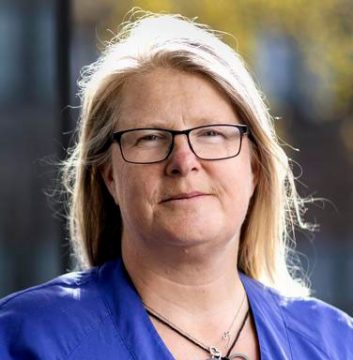INTER-ACTION. Almost half a million Swedes have hypothyroidism, an underactive thyroid gland. Four out of five affected are women and the number of cases among young women is increasing. Despite this, there are no national guidelines, no national healthcare program, and no national quality registry. On June 15, Helena Filipsson Nyström participated in a parliamentary seminar to urge politicians to act.
All political parties were invited to the parliamentary seminar, which was organized by the Thyroid Patient Association. The aim was to increase the visibility of the patient group and draw the attention of politicians to the need to improve healthcare so that patients can get the help they need.
“Today, thyroid disease is taken lightly. To put it bluntly, it concerns women doing poorly. Women’s diseases are neglected, and doing poorly is easy to dismiss. We treat the patients’ abnormal thyroid values, but still not everyone gets well. It is believed that on an international basis up to 20 percent have residual brain fatigue. We do not know the cause of this and the knowledge of what to do about it is not extensive. Healthcare is often at a loss,” says Helena Filipsson Nyström, who participated as a representative of the healthcare sector.
Can be concealed by high levels of sick leave

Helena Filipsson Nyström is Associate Professor of Endocrinology and Senior Lecturer at the Institute of Medicine, working at the Wallenberg Center for Molecular and Translational Medicine. She encounters these patients daily in her work as a Senior Consultant at the Thyroid Clinic at Sahlgrenska University Hospital.
“Many patients report mental symptoms, such as brain fatigue and exhaustion. It can have several causes but affects the quality of life and the ability to work may be reduced with sick leave. The lack of follow-up means that we know very little about how the patient group is doing and the nature of co-morbidity. In the Thyroid Patient Association’s own survey, half of the patients with hypothyroidism stated that they had never been called to arrange a follow-up appointment of their treatment with their doctor,” she says.
Helena Filipsson Nyström is currently planning a residency project that will investigate sick leave among patients with thyroid diseases and a PhD project on nursing in Graves’ disease, which is a form of hyperthyroidism (over-functioning of the thyroid gland). The project will focus on how to improve the prognosis for those with brain fatigue.
She is also conducting a study to investigate what happens in the brain structurally, functionally, and immunologically during brain fatigue in patients with Graves’ disease.
One in ten women affected
 More than 12,400 people were treated for hyperthyroidism in 2022 and the risk of being affected by the disease is six times higher in women. The disease has recently been assigned a national healthcare program, led by Helena Filipsson Nyström, chair of the national healthcare program group. The hope is that this will lead to better and more equal care.
More than 12,400 people were treated for hyperthyroidism in 2022 and the risk of being affected by the disease is six times higher in women. The disease has recently been assigned a national healthcare program, led by Helena Filipsson Nyström, chair of the national healthcare program group. The hope is that this will lead to better and more equal care.
However, for the large group of patients treated for hypothyroidism, more than 483,000 people in 2022, a national healthcare program is still missing. The National Program Area for Endocrine Diseases is discussing this with the National Board of Health and Welfare.
During the meeting, the patients’ association called on politicians to take three actions:
– Mandate the National Board of Health and Welfare to develop national guidelines for more thyroid diseases.
– Provide targeted funding for treatment research.
– Add thyroid diseases to the list of diagnoses when focusing on women’s diseases.
The importance of patient engagement
Helena Filipsson Nyström has been working closely with the Thyroid Patient Association for the past two years. She also includes patient representatives in her own research.
“In our research department, we aim to set up a patient council to provide valuable input for all our endocrine research. I just submitted an application to the Swedish Research Council’s treatment research where it is of great importance throughout. “The treatment of thyroid diseases needs to be better and more equal, but more research is also needed to solve questions that are currently a mystery, both for us in the healthcare system and for the patients,” she says.
TEXT: KARIN ALLANDER
PHOTO: JOHAN WINGBORG, THYROID PATIENT ASSOCIATION
Read more
– Helena Filipsson Nyström’s research team
– Thyroid Patient Association (In Swedish)











